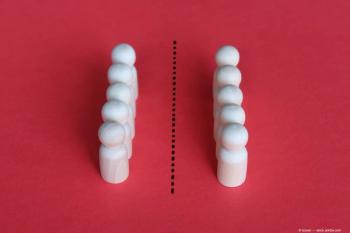
Troubleshooting post-presbyopia IOL complaints
With modern presbyopia-correcting IOLs, patients are generally happy with their quality of vision after surgery.
Nevertheless, some patients are unhappy even with Snellen visual acuity of 20/20 or better. While it may sometimes be tempting to dismiss these patients as unreasonable or “crazy,” understanding what makes these patients dissatisfied even with good Snellen visual is important for their proper management.
When using presbyopia-correcting IOLs, I always evaluate patients after the first eye is done before proceeding to the second eye. This way, I can address any potential visual quality and function issues prior to committing to the second eye.
If a patient says things are “blurry,” I first make sure that they are describing their best-corrected visual acuity in the pseudophakic eye.
If they are still wearing old glasses or if they are being distracted by their cataractous eye, then proceeding with the second eye surgery makes sense.
However, if they are indeed unhappy about the vision in the operative eye, I have them describe their symptoms in more detail.
Dissatisfaction with vision in spite of good Snellen acuity can be grouped into two primary causes: issues of edge-contrast (visual quality) and night-vision symptoms (dysphotopsias).
I distinguish these two categories by having patients describe the situation(s) in which they are unhappy with their vision. If their complaints are related to the sharpness of letters when looking at an eye chart, the issue is visual quality. If their complaints are primarily related to what they see around lights at night, the issue is dysphotopsia. In both cases, I try to correlate their descriptions with what I know is going on optically with the lens implant and eye.
Visual Quality: What happens at the edge
Visual acuity is dependent on the ability to distinguish the edges of an optotype (such as an E on the eye chart). Both contrast (the difference in intensity between the background and the foreground) and brightness (light) help us to discern the edges.
In an ideal situation, contrast and brightness are both at 100%, and there is no blur, providing a nice, sharp optotype and a high-quality visual experience (Figure 1).
Contrast and lighting are related. In the example above, when the light is dimmed, the optotype remains black while the background becomes darker, so the edge of the optotype becomes harder to distinguish. This is because the intensity difference between the foreground and background decreases (Figure 2a).
Similarly, if contrast sensitivity is decreased, the optotype becomes lighter while the background remains white, so there is a corresponding reduction of intensity difference between foreground and background (Figure 2b).
If lighting is dimmed in a low contrast state, the effect is compounded, and the optotype becomes even more difficult to see (Figure 2c).
In general, if a patient is having trouble with contrast, the simplest thing to do is to turn up the light.
Blur can be thought of as a spreading of the transition between foreground and background (Figure 3). Instead of a sharp transition from black to white, the edge transition of the optotype becomes more gradual. As the amount of blur increases, the relative contrast at the edge decreases, making it increasingly difficult to distinguish a crisp separation between black-and-white (Figure 3a, b, and c).
Increasing illumination can help to some degree, but magnifying the object (e.g. by moving it closer) makes it easier to see (Figure 4a, b, and c).
Other times a patient might say the letter itself is sharp but there’s a “glow” or a “shadow” or “fuzziness” around it (Figure 5).
This can occur in patients with multifocal IOLs or even extended-depth-of-focus (EDOF) IOLs. Since there is a sharp edge present, patients with these symptoms typically have good visual acuity and function and basically need reassurance and time for neuroadaptation. Even in a discerning, Type A patient, the process of neuroadaptation can take several months, rarely needing an IOL exchange for improvement.
With any of these manifestations of “blurry” vision, one should always look for possible secondary causes such as residual refractive error, dry eye, posterior capsular opacification (PCO), and cystoid macular edema.
Dysphotopsias: Vision in the dark
Another reason that patients might be unhappy with objectively 20/20 vision is dissatisfaction with the quality of vision at night. Dysphotopsias are the result of out-of-focus light hitting the retina. Whether from ocular aberrations, lenticular light scatter, or pseudoaccommodating IOLs, dysphotopsias vary greater in brightness and appearance.
For clinical trials, the FDA classifies dysphotopsias into three distinct categories: glare/flare; halo; and starburst. Each of these has a different appearance to the patient and occurs for different optical reasons (Figure 6).
Glare or flare, which may also be described as smearing or blur around the point source of light, can be due to refractive error, ocular surface problems, PCO, and nuclear cataracts; and it is less likely to be directly associated with any particular IOL optics.
Halo, or a ring around the point source of light, is common with multifocal IOLs. These lenses have two focal points, which can be seen on a defocus curve as two peaks. Between the two peaks, there is a drop-off in energy distribution in the intermediate range. That dip in the defocus curve correlates with a dip in off-axis light, or the gap between the center and the ring in the halo. The size of the halo is related to add power, with larger halos associated with higher add powers.
Starbursts may be described by patients as streaks or rays of light emanating from the point source. These can occur with refractive error, ocular surface problems, posterior capsular folds/PCO, or diffractive IOLs.
Dysphotopsias can also occur in different forms and/or combinations (Figure 7).
When looking at illustrations of dysphotopsias, it is important to recognize that the ability to represent dysphotopsias in a picture is limited by the contrast of the paper or display on which we view at the illustration. With only 256 levels of gray, our digital images are a far cry from the contrast ratios relevant to night vision, which can be greater than 1:1,000,000.
As new presbyopia-correcting IOLs become available, the differences in optics and design mean new trade-offs between depth of focus and dysphotopsias.
For example, while diffractive multifocal IOLs can produce a single bright halo, diffractive EDOF IOL patients tend to describe starbursts and multiple fine concentric halos that produce a “spider-web” effect.
Overall, I have seen greatly reduced night vision complaints with EDOF IOLs as compared to multifocal IOLs, but I foster this with appropriate preoperative counseling.
Conclusion
In conclusion, whether it’s visual quality or dysphotopsias, we have much more to learn about how our presbyopia-correcting IOL patients’ visual experiences correlate to our traditional clinical testing results.
Instead of shunning patients with visual quality complaints following implantation of these lenses, we should embrace the opportunity to learn from their symptoms not only for how best to manage them, but also better to counsel future patients-and to create our next generation of IOLs to correct presbyopia.
Disclosures:
Daniel H. Chang, MD
P: 661/325-3937
E:
Dr. Chang is in private practice at Empire Eye and Laser Center in Bakersfield, CA. He is a consultant to Johnson & Johnson Vision.
Newsletter
Don’t miss out—get Ophthalmology Times updates on the latest clinical advancements and expert interviews, straight to your inbox.








































